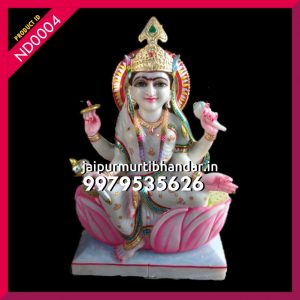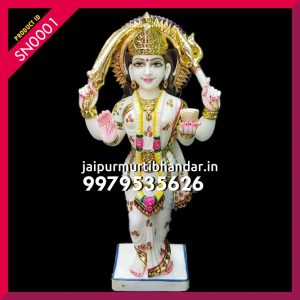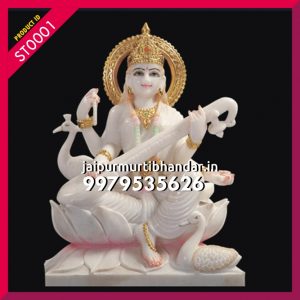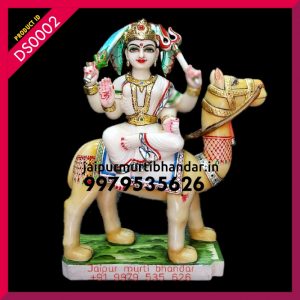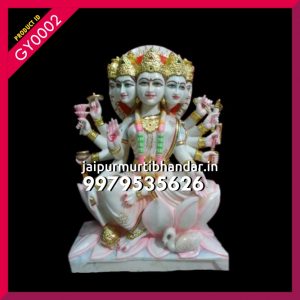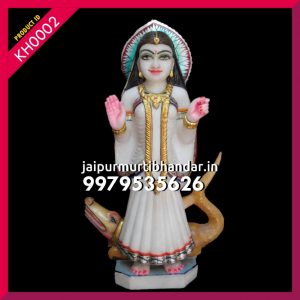-
Navdurga Maa : ND-0001
Navdurga, are the nine forms of Durga collectively worshipped by Shakti devotees. Scriptures differ in naming the nine incarnations. Pictures and paintings of the Nava-Durga also varies from region to region. The most widely accepted account of the nine forms of Durga is the one found in the Devi Mahatmya ? Sailaputri, Brahmacharini, Chandraghanta, Kushmanda, Skanda Mata, Katyayani, Kalaratri, Maha Gowri and Siddhidayini.
The nine forms of Durga are worshipped during the nine days of Navratri. -
Navdurga Maa : ND-0004
Navdurga, are the nine forms of Durga collectively worshipped by Shakti devotees. Scriptures differ in naming the nine incarnations. Pictures and paintings of the Nava-Durga also varies from region to region. The most widely accepted account of the nine forms of Durga is the one found in the Devi Mahatmya ? Sailaputri, Brahmacharini, Chandraghanta, Kushmanda, Skanda Mata, Katyayani, Kalaratri, Maha Gowri and Siddhidayini.
The nine forms of Durga are worshipped during the nine days of Navratri. -
Navdurga Maa : ND-0007
Navdurga, are the nine forms of Durga collectively worshipped by Shakti devotees. Scriptures differ in naming the nine incarnations. Pictures and paintings of the Nava-Durga also varies from region to region. The most widely accepted account of the nine forms of Durga is the one found in the Devi Mahatmya ? Sailaputri, Brahmacharini, Chandraghanta, Kushmanda, Skanda Mata, Katyayani, Kalaratri, Maha Gowri and Siddhidayini.
The nine forms of Durga are worshipped during the nine days of Navratri. -
Santoshi Maa : SN-0001
Santoshi Maa is a relatively new goddess in the Hindupantheon. She is venerated as “the Mother of Satisfaction”, the meaning of her name. Santoshi Mata is particularly worshipped by women of North India and Nepal. A vrata (ritual fast) called the Santoshi Maa vrataperformed by women on 16 consecutive Fridays is believed to win the goddess’ favour.
Santoshi Mata emerged as the goddess in the early 1960s. Her cult initially spread through word of mouth,vrata-pamphlet literature, and poster art. Her vrata was gaining popularity with North Indian women. However, it was the 1975 Bollywood film Jai Santoshi Maa(“Hail to Santoshi Maa”)?narrating the story of the goddess and her ardent devotee Satyavati?which propelled this then little-known “new” goddess to the heights of devotional favour.
-
Saraswati Maa : ST-0001
Saraswati’s name means ‘elegant’, ‘flowing’, and ‘watery’ and this is indicative of her status as one of the early Aryan boundary rivers. The Saraswati River (modern name: Sarsuti), just like the Ganges River, flows from the Himalaya and is considered a sacred source of purification, fertility, and good fortune for those who bathe in her waters. The sacred river, again like the Ganges, then developed into a personified deity.
-
Brahmani Maa: BRM-0002
The Brahmani Mata also known as Brahmi and Brahmayi is a kind and benevolent aspect of Devi, the Divine mother. The Brahmani is associated with the Hindu creator god, Brahma as his Shakti power. She is one of the seven Mother Goddesses called Matrikas. She is an aspect of Mata Saraswati, a form of Adi Shakti, possessing the Rajasi Guna and hence is the source of Brahma's power. Without her, Brahma remains dormant or unable to create.
She is depicted yellow in color and with four heads. Like Brahma, she holds a rosary or noose and kamandalu or lotus stalk or a book or bell and is seated on a hansa as her vahana.
-
Chotila Maa: CH-0002
Chamunda Mata is when the two demons named 'Chanda' and 'Munda' good for the road for many years thanks to the Lord Brahma. Brahma was pleased when he appeared before them and asked the demons warriors strong and dominate the world and into the sky. Brahma was merciful wish.There granted to the chaos of the world and demons became very greedy and tried to revive the sky and the three houses of Vishnu (Vaikuntha), Shiva (Kailas) and Brahma (Brahmaloka). Three gods went to the mother goddess Parvati who took the form of Chandi and Chamunda who murdered Chand mund.
-
Dasha Maa: DS-0002
Goddess Durga a super powerful deity ? Shakti? in Hindu mythology is worship in various forms corresponding to her to aspects benevolence and fierceness. She is Uma, “glow”; Gauri, “white or brilliant”; Parvati, “the mountaineer”; and Jagatmata, “the-mother-of-the-world” in her milder guise The terrible appearance are Durga “the inaccessible”; Kali, “the black”; Chandi, “the fierce”; and Bhairavi, “the terrible.”
Durga, a gorgeous warrior riding upon a tiger or Lion. Devi Durga with a lion in a fearless pose is known of “Abhay Mudra”, signifying assurance of freedom from fear. The universal mother seems to be saying to all her devotees: “Surrender all actions and duties onto me and I shall lift you from your all troubles “.
-
Durga Maa: DU-0002
Goddess Durga a super powerful deity ? Shakti? in Hindu mythology is worship in various forms corresponding to her to aspects benevolence and fierceness. She is Uma, “glow”; Gauri, “white or brilliant”; Parvati, “the mountaineer”; and Jagatmata, “the-mother-of-the-world” in her milder guise The terrible appearance are Durga “the inaccessible”; Kali, “the black”; Chandi, “the fierce”; and Bhairavi, “the terrible.”
Durga, a gorgeous warrior riding upon a tiger or Lion. Devi Durga with a lion in a fearless pose is known of “Abhay Mudra”, signifying assurance of freedom from fear. The universal mother seems to be saying to all her devotees: “Surrender all actions and duties onto me and I shall lift you from your all troubles “.
-
Gayatri Maa: GY-0002
Gayatri Devi is an incarnation of Saraswati Devi, consort of Lord Brahma, symbolising the “shakti” (strength) and “dev” (quality) of Knowledge, Purity and Virtue. Saraswati Devi is held to be the patronness of the Arts, being a poet and musician, as well as skillful composer. In the form of Gayatri Devi, with the blessings of Lord Brahma, she is believed to have given the four Vedas to mankind.
Goddess Gayatri
Gayatri is depicted seated on a lotus. She is depicted with five faces representing the pancha pranas /pancha vayus(five lives/winds): prana, apana,vyana, udana, samana, of the five principles/ elements (pancha tatwas) earth, water, air, fire, sky (prithvi, jala, vayu, teja, aakasha). She has 10 hands carrying the five ayudhas: shankha; chakra, kamala, varada, abhaya, kasha, ankusha, ujjwala utensil, rudrakshi mala. -
Khodiyar Maa: KH-0002
Khodiar Mata is the revered Goddess, who is worshiped by many sects of the Hindu faith. Elaborate statues of this deity can be availed from us at exceptionally affordable prices. These statues are polished with fine material, which has a lasting finish. Furthermore, our range of statues is a true representation of our cultural heritage.
-
Laxmi Maa : LX-0002
Lakshmi is also called Sri or Thirumagal because she is endowed with six auspicious and divine qualities, or gunas, and is the divine strength of Vishnu. In Hindu religion, she was born from the churning of the primordial ocean (Samudra manthan) and she chose Vishnu as her eternal consort.When Vishnu descended on the Earth as the avatars Rama and Krishna, Lakshmi descended as his respective consort.In the ancient scriptures of India, all women are declared to be embodiments of Lakshmi.The marriage and relationship between Lakshmi and Vishnu as wife and husband is the paradigm for rituals and ceremonies for the bride and groom in Hindu weddings. Lakshmi is considered another aspect of the same supreme goddess principle in the Shaktism tradition of Hinduism
Lakshmi is depicted in Indian art as an elegantly dressed, prosperity-showering golden-coloured woman with an owl as her vehicle, signifying the importance of economic activity in maintenance of life, her ability to move, work and prevail in confusing darkness.She typically stands or sits like a yogin on a lotus pedestal and holds lotus in her hand, a symbolism for fortune, self-knowledge and spiritual liberation.Her iconography shows her with four hands, which represent the four goals of human life considered important to the Hindu way of life: dharma, k?ma, artha, and moksha.
Godess Idols
- Home
- Shop
- Marble Statue
- Godess Idols

 +91 9979 535 626
+91 9979 535 626
